Yesterday I received a request from Montana Fish, Wildlife and Parks to use one of my photos of a pronghorn fawn snagged in a barbed wire fence for an interpretive panel about the impacts of development on wildlife. They found that photo in one of my older blog posts. In the process of confirming precisely which image they were interested in I read that post again last night for the first time in almost four years.
I think it’s an interesting and thought provoking post worthy of a rerun so today I’m publishing it again, which is something I do occasionally. For this version I’ve cleaned up the formatting and edited some of the text. The original post was published on July 7, 2016.
Apologies to long time veterans of Feathered Photography who have seen it before.
I’m growing weary of featuring wildlife encounters with barbed wire on my blog and I’m sure some of my readers are too, which is why I’ve put this post off for over a month. But dammit, I just can’t stick my head in the sand and pretend this kind of thing doesn’t happen. I’ve documented a dead Burrowing Owl strung up in the stuff, rescued a Barn Owl hanging from it that was eventually released back to the wild and Mia and I recently rescued a Short-eared Owl whose wing was so badly mangled by the wire that its best hope is to be kept in captivity and used as an education bird for the rest of its life. I’ve even photographed a dead bat hanging from barbed wire. And a month ago it happened again, this time it was a young pronghorn fawn hung up in barbed wire. Barbed wire has been called “devil-rope” for over a century now and for good reason.
For the more sensitive types please know that there are no gory photos here although a couple of them may tug at your heartstrings. All images were taken in Montana’s Centennial Valley, most of them last month.
But first a little background.
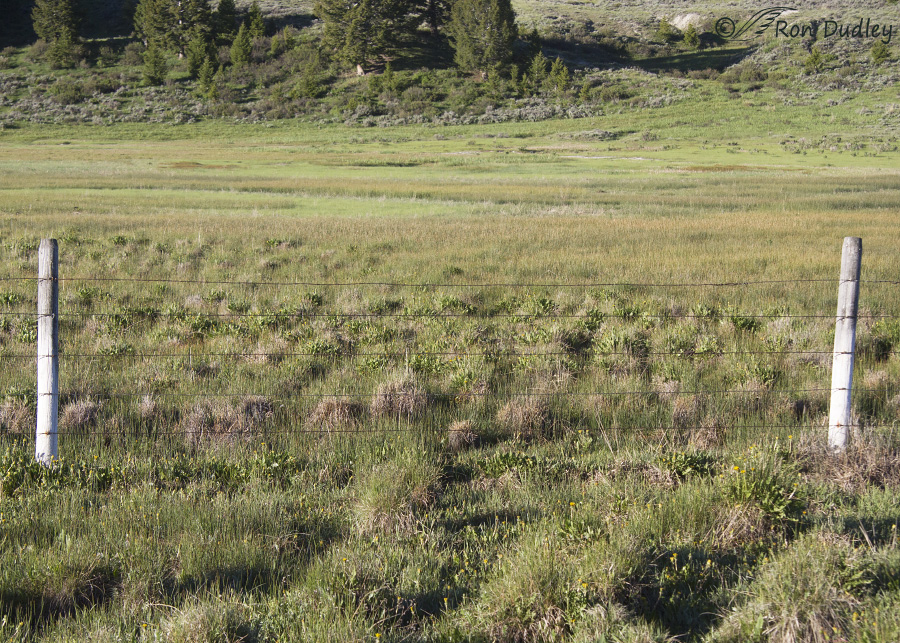
Montana’s spectacularly beautiful Centennial valley is huge and most of it is privately owned by cattle ranchers who must contain their cattle with fences. There are hundreds of miles of fences in the valley and nearly all of them are made of barbed wire.
This five-stranded barbed wire fence is typical but some have as few as three strands and others have up to six. Different types of wire are occasionally used but barbed wire is the norm.
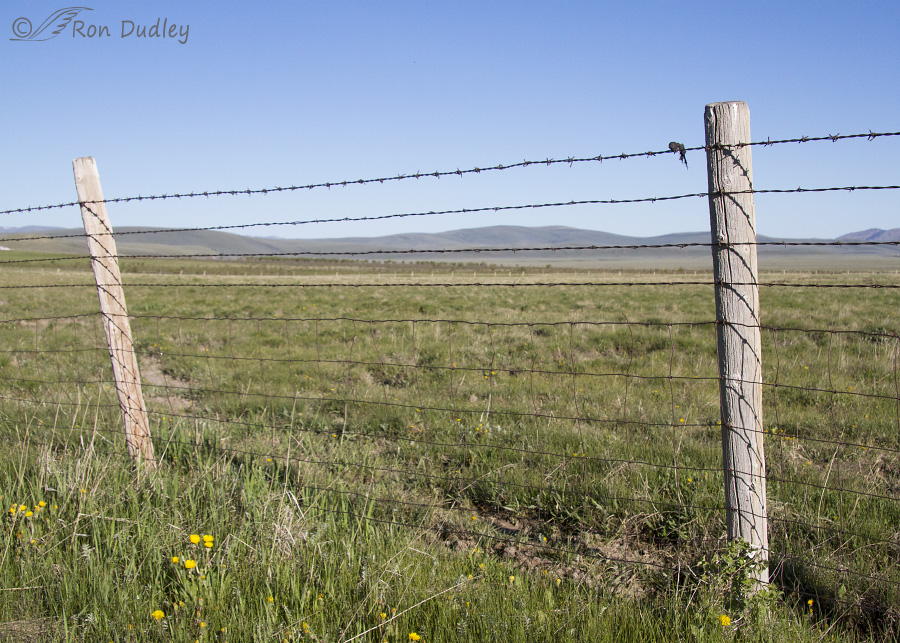
Some of the fences have so many strands of several wire types that nothing bigger than a jackrabbit could get through them. But most fences in the valley are made only of barbed wire.
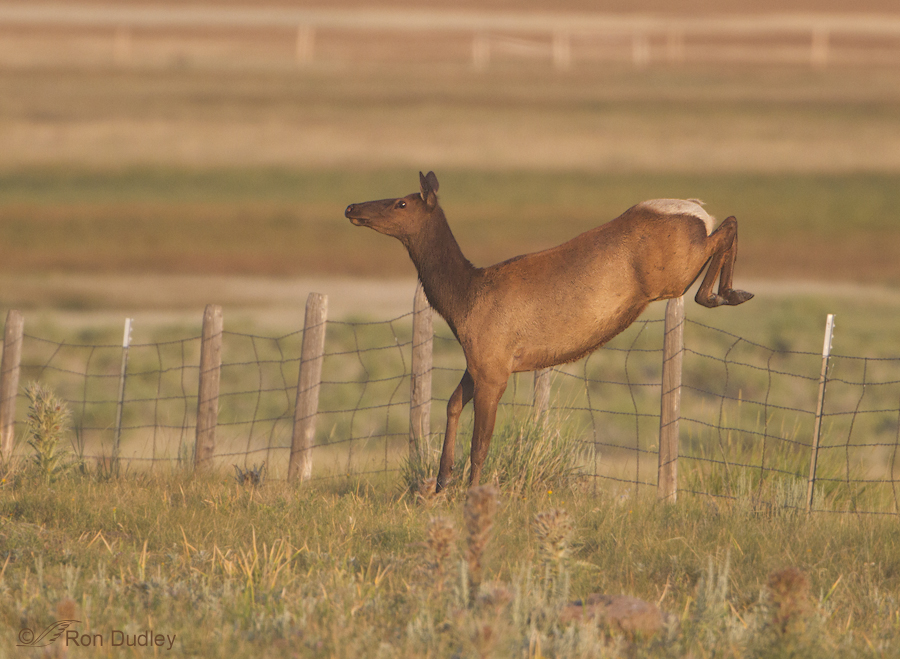
Most large adult mammals like elk and deer generally have no difficulty jumping the fences. The biggest danger to them is getting their hind legs caught between two closely-strung wire strands at the top of the fence as they’re clearing it and that does happen occasionally but typically they negotiate the fences successfully.
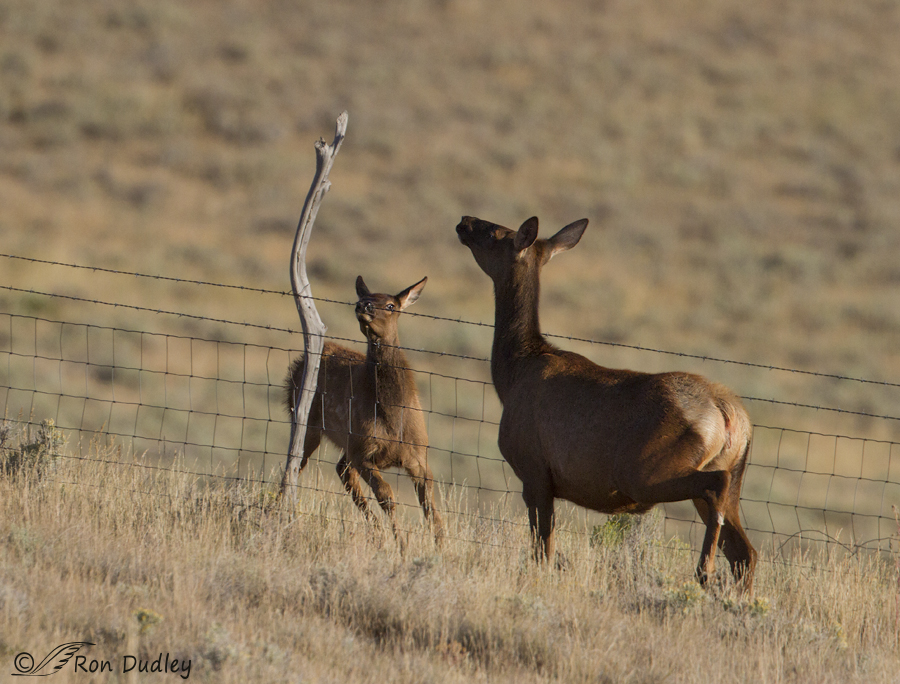
Young deer and elk are often another story. This cow elk and her calf (on a hillside, thus the slant of the image) became separated from each other by the fence and both panicked until they found a weak spot in the fence the calf could pass through.
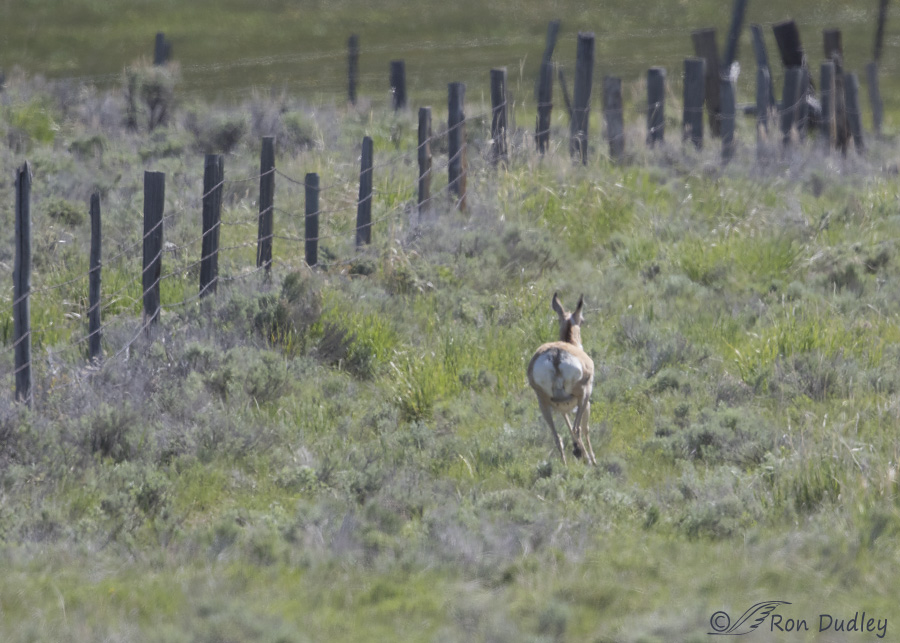
But in the American West the biggest danger of barbed wire for large, wild mammals is to pronghorn. Interestingly this species, the second-fastest land animal in the world (second only to the cheetah so it must have very powerful legs), typically doesn’t jump fences. It either can’t or it won’t. Usually. In six decades of sporadically watching pronghorn I’ve only seen a pronghorn jump a fence a single time. Pronghorn much prefer to find a weak spot in the fence and scoot under it and that’s what they nearly always do.
When I approached in my pickup this pronghorn was caught between two fences lining the road. It panicked as it desperately looked for a spot in the fence it could get through. I stopped and watched and it eventually made it through a weak spot in the fence. But if I’d have proceeded at my original speed it likely would have taken a chance on a less open spot in the fence and it could easily have become entangled in the barbed wire.
It isn’t unusual to find old pronghorn hides hanging from barbed wire fences. I’ve seen it many times myself, especially in Montana but also in Wyoming and Utah.
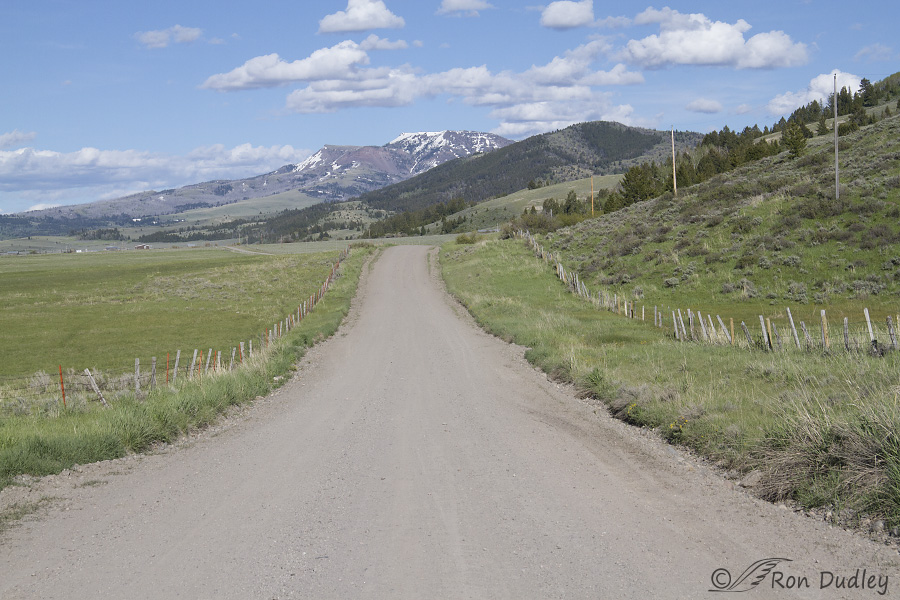
This is the South Road, the 30 mile long gravel road running east/west through the entire Centennial Valley. Whenever a vehicle comes by it’s a gauntlet of barbed wire for any large mammal caught between the fences on both sides of the road. Those vehicles include huge, intimidating and noisy logging and cattle trucks but even a single small car can cause panic in a pronghorn caught between the fences.
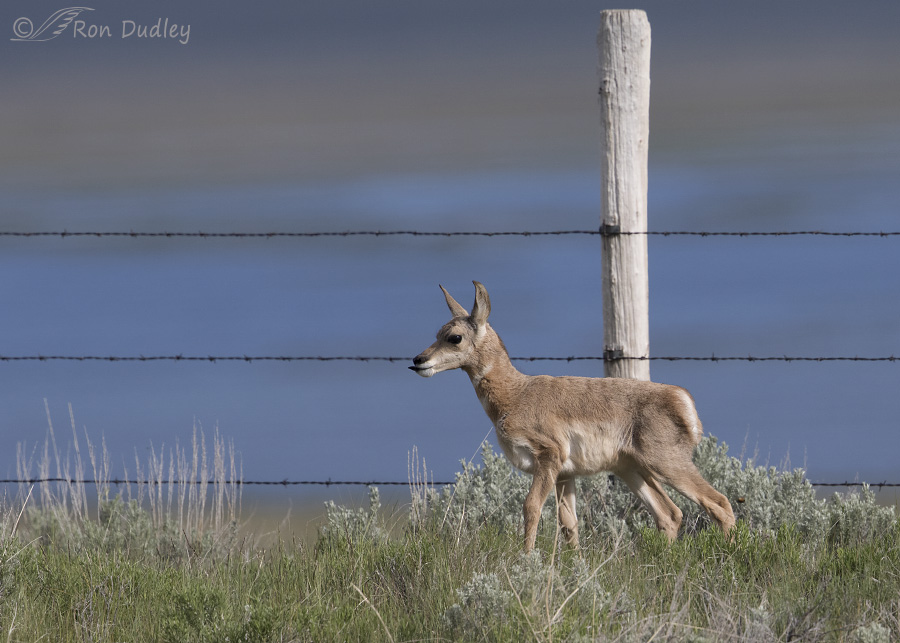
When there’s no threat from vehicles pronghorn seem to accept the fences as part of their environment, just as this young fawn was doing as it frolicked near the fence line with its mother nearby. But when a vehicle comes along, acceptance can turn to panic in an instant.
And last month I was inadvertently the cause of just such an incident.
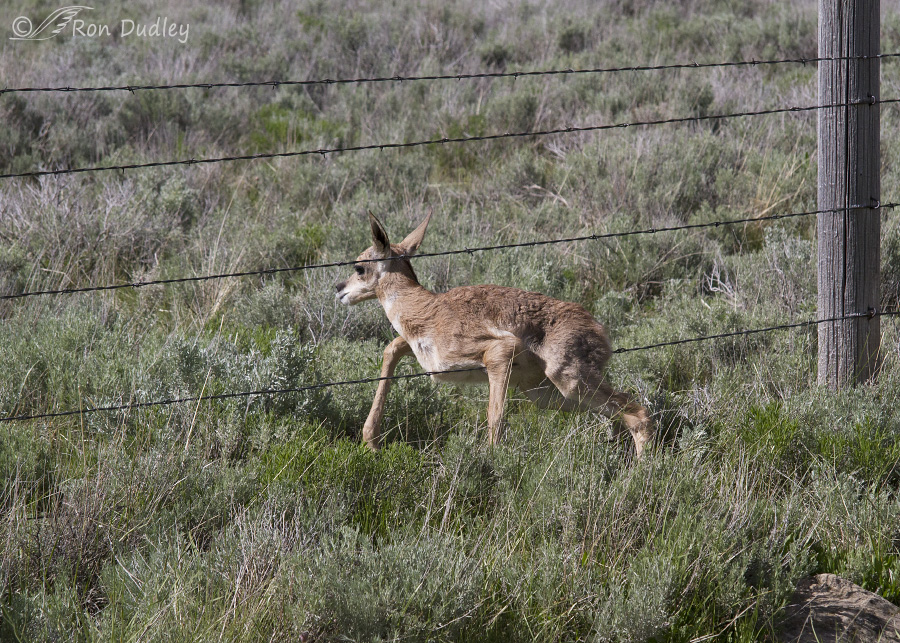
Just over a month ago I was driving the South Road looking for birds when I spotted a doe pronghorn with very young twin fawns in front of me and they were trapped between the fences on either side of the road. As soon as I saw them I slowed to a crawl to allow them to find a spot in one of the fences where they could cross to safety. Eventually the adult and one of the twins made it through the fence but the other youngster wasn’t so lucky and was snagged on the bottom wire of the fence.
I got out of my pickup and approached the young pronghorn slowly and as I did the other two moved off to a safe distance. The fawn was firmly snagged by a single barb under its left front “armpit” and though it struggled to free itself it just couldn’t.
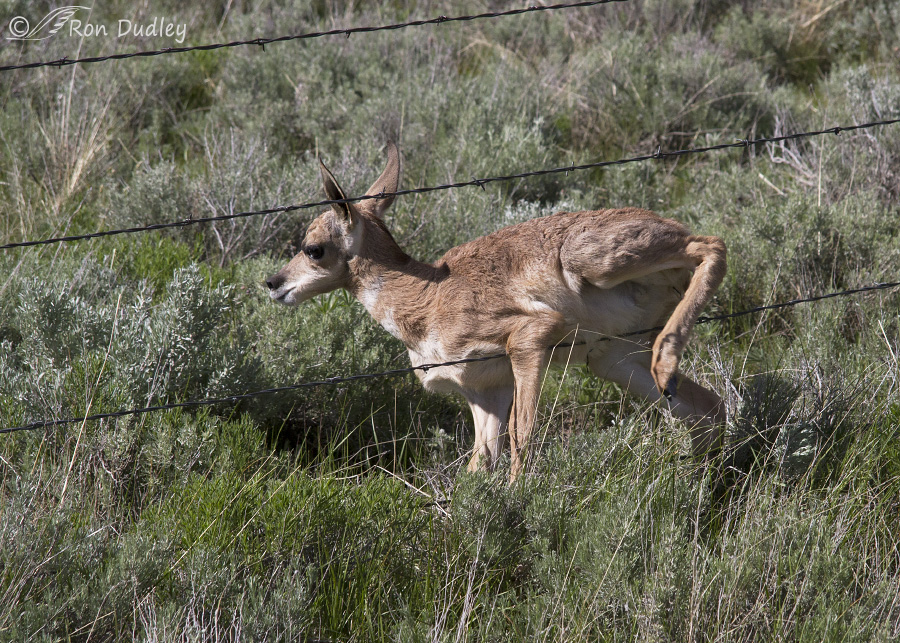
A closer look shows that the rear leg wasn’t caught in the wire, only the front one.
As I reached down to free the fawn I was struck by how tough and wiry “he” felt (I didn’t take the time to determine sex). I guess I expected him to feel soft like some other mammal babies but he was far from it. He was bleating like a lamb in fear and the little rascal kicked my right arm hard with his left rear leg. Good for him! His survival instincts were definitely intact.
Thankfully very little damage had been done in that short time, just a little blood under his left front leg when I extracted him from the wire. As soon as he was free he was off like a shot and joined his mother and sibling.
I wish something could be done about these fences. I realize that ranchers have to contain their livestock but it seems to me that with a little effort and ingenuity a fence design that’s safer for wildlife could be developed. I know from conversations I’ve had with staff at nearby Red-rock Lakes National Wildlife Refuge that efforts are being made to influence local ranchers in that direction.
Ron
PS – Another event involving a fawn pronghorn (but no barbed wire) on this trip left us heartbroken. Precisely at dawn I was approaching the South Road from the road to the lower lake campground when a pickup came along from the east. I waited for him to go by before I pulled onto the road because I knew I would be going very slowly as I looked for birds but I had to wait a while because he was driving very slowly himself (perhaps 20 mph on the gravel road).
But within minutes after I pulled onto the road I noticed that the pickup had stopped in the middle of the road in front of me. Its driver got out, looked behind his vehicle and then walked back to us and he was almost in tears. He was a biologist for the refuge and he had struck a newborn pronghorn fawn laying in the middle of the road and killed it – the youngster had raised its head as the pickup passed over it. Fawns this young instinctively hunker down to hide and the biologist simply didn’t notice it. They’re very small at this age – without their long, gangly legs they’re not much larger than a jackrabbit.
Needless to say that tragic event put a significant damper on the rest of our day.
Notes:
- The image that Montana Fish Wildlife and Parks is interested in is the last one in this post.
- When this post was originally published readers provided many thoughts (and links) to potential solutions to the barbed wire dilemma. There are ways to deal with it but many of the proposed solutions are expensive and some would say impractical.
- It’s a long background story so I won’t go into it but when I was a kid of about 8 or 9 I ran into a taughtly stretched strand of barbed wire while running full speed. The barbs ripped my upper belly open deeply enough that I could see fat in the wounds and that terrified me. I had those scars on my belly for many years.


Thanks for being there and rescuing these critters. Such beautiful country in your photos.
From Wikipedia article on barbed wire:
“Because of the risk of injuries, in 2010 Norway prohibited making new fences with barbed wire for limiting migration of animals.[38] Electric fences are used instead. Consequently, Rolls-Royce Motor Cars is using Norwegian hides for producing leather interior in their cars, since the hides from Norwegian cattle have fewer scratches than hides from countries where barbed wire is used.”
From barb-aric to humane and back again. Gotta have those Big Macs and plush interiors.
I think some of the results of your little research project are fascinating, Lyle. Talk about unexpected consequences.
And I enjoyed your “barb-aric” play on words too.
It would be nice to see changes made. Sometimes it takes a long time to do.
And sometimes the changes are never made…
People NEED TO SEE THIS….I HATE THE DAMNED STUFF!!!!!!!!!!!!!!! for showing it…still can’t get image of own hung up in the f-ing stuff…DEVIL WIRE…
for showing it…still can’t get image of own hung up in the f-ing stuff…DEVIL WIRE…
I remember how you hate barbed wire, Patty.
Oh Ron.
As a child I was often snagged by barbed wires. I bled, I made a bit of a mess of myself and my clothing, but my life was never threatened.
Thank you for freeing this little guy, and despite my sadness, thank you for reposting.
I do hope that a solution can not only be found, but adopted. I am not going to hold my breath though – blue is not my colour.
It’s amazing how effective those barbs are at snagging us when we try to cross one of the fences isn’t it. I was a bloody mess many times as a result. Thanks, EC.
Thanks for re-posting this now. It seems even more timely given current circumstances don’t you think? When–during a global health crisis–powerful national political figures dare to publicly suggest that sacrificing some of our human population in order to save the stock market should be factored into strategies for addressing a human pandemic, one can only guess how shallow are those folks’ values when it comes to other species. Human development–and the belief that our population must be encouraged to grow limitlessly in order to ensure ever growing human economies–may, in fact, have a role in spawning the coronavirus scourge. That being just one of the multitude of scary ways by which Mama Nature is able to rein in any of her excessively fecund, overly ambitious off-spring. Barbed wire fences may seem a long stretch from our present human dilemma but every environmental advocate can quote John Muir on that…”tug on one thing in the universe and you’ll find it is connected to everything else.”
That is the one key lesson those less sympathetically disposed to other living things and the natural world may only learn on the day when the tug comes for them and their loved ones.
Glad you got the little bugger freed…this time. Keep posting these potent visual tales.
“When–during a global health crisis–powerful national political figures dare to publicly suggest that sacrificing some of our human population in order to save the stock market should be factored into strategies for addressing a human pandemic, one can only guess how shallow are those folks’ values when it comes to other species.”
Excellent, excellent point, Jim!
And your entire comment is well taken. Thanks taking the time to say it so well.
Dumb question, why does it have to be “barbed” wire? Why can’t it be just non-barbed kind? I would think it would work just as well to contain cattle. Thanks for the post.
Elmer, cattle are notorious for pushing the limits of any barrier between them and where they want to go. Without at least some barbs, or electrified fence, or some other kind of deterrent they’re likely to get through most any kind of man-made barrier. And once one gets through the others follow.
AMEN!
More than a dozen years ago when I was viewing a lek of dancing Gunnison sagegrouse from a blind supplied by Colorado’s (then) Division of Wildlife, I saw a bird keel over. It was later picked up by a coyote. Eventually I realized the dead bird had hit a barbed wire as it came to the lek.
More recently, in Oklahoma during a lesser prairie chicken festival, I heard about the use of flags to warn these birds of dangerous barbed wire, as described by Don above. Apparently if placed close enough, the flags can protect these rare birds and likely other animals. Of course putting flags on the miles of barbed in the West would take a lot of effort. Small young deer and pronghorn usually know of the fence, but don’t know how to deal with it. So they likely wouldn’t be helped.
Nancy, some of the fences in the Centennial Valley where Sage Grouse are common are flagged. Only a small percentage of the total though. The fences near the Hennifer lek here in Utah are flagged.
Hello Ron. You have again stated the perils of Barbed Wire and the dire consequences of Wildlife who snag, and impale them selves onto it. Regarding Antelopes; my wife and I personally witnessed 2 adult Antelope, within a few feet of each other, both jump and clear a Barbed Wire barrier in Colorado, on our way to Gunnison, CO, for a Sage Grouse Conference a few years back. The road we traveled was identical to your posted photo of Barbed Wire barriers on both sides of the road, and the Antelope we saw as we came around a curve were also on the road. As we search the FBO business opportunity sights for opportunities to promote our FENCE-FLAGS® (WWW.FENCE-FLAG.COM) we have noticed an effort by the BLM and other Wildlife concerned parties, to insist on the bottom strand of wire to be Barbless for their fence contracting installations.This attribute for the bottom strand, though not mentioned, is I’m sure a recognized mitigating factor to NOT harm, by snagging or simply cutting, those that choose to force them selves under a wire barrier fence. We have personally witnessed White Tail Deer force their body under a very tight (smooth Wire) High Tensile Wire barrier, that we were amazed at their determination to crawl under, with the contortion they put their body thru to get through. Had the bottom strand been Barbed Wire it would have been a cut and slice disaster. Wishing you good health–Don
“insist on the bottom strand of wire to be Barbless”
I think that’s an excellent step in the right direction, Donald.
I remember when we all joined in on the discussion of barbed wire on your past post. I have never seen one of our Pronghorns jump a fence, but often have seen them crawl under a spot where the wire is broken or bent. So glad you were there and got that one little guy through. And of course being stuck in barbed wire without human help leaves you there for the coyotes. I remember often climbing through or over barbed wire as a kid and often getting snagged. Certainly when we can launch rockets to locations in space that we never even previously knew were there, we can find an alternative to barbed wire.
Of course replacing miles and miles of barbed wire for ranchers would be very expensive in money and time. To get it started might require the government to offer a tax deduction to ranchers willing to do it.
“I remember often climbing through or over barbed wire as a kid and often getting snagged”
I have similar memories, Everett. That stuff is nasty. When horses get caught in it they panic and fight it. The results are often horrific.
Been there, done that crossing barbed wire since I’m a “shorty”. Our Vet has photos of some of that damage to horses – their hide isn’t like cow hide and they “jerk”…….
Our Vet has photos of some of that damage to horses – their hide isn’t like cow hide and they “jerk”……. 
It is a hard reality of fencing and barbed wire in particular. White tailed fawns are also known to get caught trying to crawl through rather than jump crawling through being common even in adults. The cost of fencing AND effectiveness of keeping cattle in is a real challenge over miles and miles of ground. Things are changing but it’s a LONG and SLOW process. Wildlife DOES pay a price sadly……. Glad FWP is trying to raise awareness…….
Glad FWP is trying to raise awareness…….
P.S. Antelope fawns ARE wiry and, if needing rescue MUCH harder to keep than deer I’m told!……
I was really surprised by how “hard” his little body felt. There didn’t seem to be an ounce of fat on him, all muscle and bone. And attitude!
Judy, Montana FW&P seems to be at the forefront of publicizing the problem and trying to come up with practical solutions. Many of the links provided by readers when I originally published this post were from them.